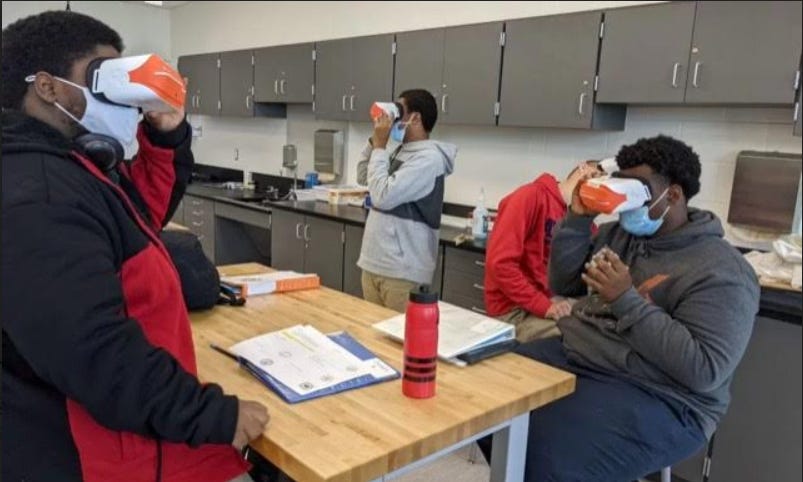VR/AR in Ohio Schools: Do You Consent?
BY NICK ROGERS
CHARDON - Virtual Reality (VR) and Augmented Reality (AR) are no longer just the stuff of entertainment. These mediums are now integrating into the education sector, as evidenced by Saint Joseph Academy (Cleveland) and their 2023 press release touting the institution as “…the first high school in the world to acquire the HoloAnatomy Software Suite.” Educators tout the technology’s potential to expand teaching capabilities, but detractors warn of inherent biological harm stemming from its use. Parents and students alike, do you consent?

“Learn Faster, Understand More” is the slogan plastered across Case Western Reserve’s HoloAnatomy webpage. The technology – used in conjunction with a Microsoft HoloLens 2 headset – is designed to give anatomy students an immersive, virtual 3D experience without the need for cadavers.
Fred Kieser, a science teacher at Saint Joseph, told Government Technology, “… when they see the virtual reality, they can walk around it and see a three-dimensional image exactly like a human, whereas on a screen or paper, it’s two-dimensional, and you don’t get a feel for how the muscles overlap.” Kieser believes this technology to be, in the long-run, a much more practical, cost-effective alternative to using cadavers.
Nancy Farrow, senior VP of AlensiaXR (formerly Llumis) – the company in charge of marketing Case Western’s invention to schools – announced this January that they are “onboarding” their second high school, Chardon’s Notre Dame Cathedral – Latin. Farrow’s product pitch goes as follows: “It’s a new realm of dynamic, collaborative education that helps students learn faster and retain more vital information. What’s remarkable is that you can all be in the same room, making eye contact as you explore the 3D body together.” She adds that this software allows for students to “…engage virtually from anywhere in the world.”
“It’s an incredible experience to send our graduates off to college or university with and should help to set them apart from their peers,” says Saint Joseph Academy President Kathryn Purcell. Kieser agrees, saying “I think this fits very well with how [high school students] are learning as they grow up now. I think in 10 years, we’ll see a lot more stuff like this.”
AR/VR is not currently limited to anatomy. A study, published in 2023 by WestEd and spearheaded by Prisms – a startup funded in part by the National Institutes of Health (NIH) – reached the conclusion that Ohio students learning algebra 1 with the aid of the company’s VR gaming goggles outperformed students learning the subject by traditional teacher lecturing and textbook assignment techniques. The study – funded in part by the National Science Foundation (NSF) – featured 514 students from Prisms-subscribed schools and spanned a period of three days. The VR-using group scored 11% higher than the control group on a post-study exam.
If Prisms’ NIH/NSF-origins don’t give the reader pause, then perhaps Northrup Grumman’s funding of Winton Woods (Cincinnati) CLASSVR learning program will. Northrup Grumman is one of the world’s most prolific weapons manufacturers and intelligence agency technology providers; a corporation with an annual revenue exceeding $37 billion.
Winton Woods’ “case study” , which involves students ages three to eighteen, spans multiple disciplines from world history to physical education. Yes, virtual physical education. But lest we mourn the potential death of physically active physical education, we perhaps should be more concerned with the microwave radiation being given off by these devices, no different than a cell phone placed against one’s head; except that these devices consume one’s entire head and face. And, just as with cell phones, children are exponentially more susceptible to this radiation.
Prof. Om Gandhi of Utah University cautions, “We have never tested microwave radiating devices directly in front of the young developing eye. The absence of proof of harm at this point does not mean that we have evidence of safety.” Samsung and Google, two of the world’s biggest telecommunications companies [and much more], are also heavily involved in VR.
Devra Davis, President of Environmental Health Trust (EHT), asks, “We want to know why is Google encouraging young children to employ a technology that has never been tested for their use when Samsung has a similar system that explicitly advises that no child under the age of 13 should be using it.”
Indeed, like Smart phones, VR devices – along with the plethora of other Smart Home devices available from thermostats to breast pumps – warn the user of the imminent exposure to radio frequencies. Cell phone manuals, paradoxically, inform users not to place the devices against the body, but then turn around and sell wireless ear buds that literally microwave one’s brain from point blank range.
Speculating about where VR and AR may be taking society is, in many ways, just that: speculation. However, with mainstream acknowledgement of the brain/computer interface agenda using AI and nanotech at its core, it seems not too far a stretch for Big Tech (and Big Brother) to achieve “The Singularity” of which Ray Kurzweil has long-since dreamed.
For those who view social media as society’s first big step away from human socialization, VR/AR – a world of absolutely spectacular all-encompassing emersion without the need for any actual proximity to other human beings – may be the first giant leap.
So, much like Elon Musk’s dichotomous view of AI as a Godsend but also potentially the cause of human extinction, VR/AR may be a miraculous learning tool with a downside we’ve only scraped the surface of. The question, as it pertains to VR/AR in Ohio schools, is, do you consent?




